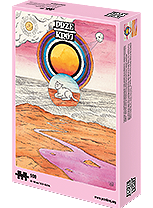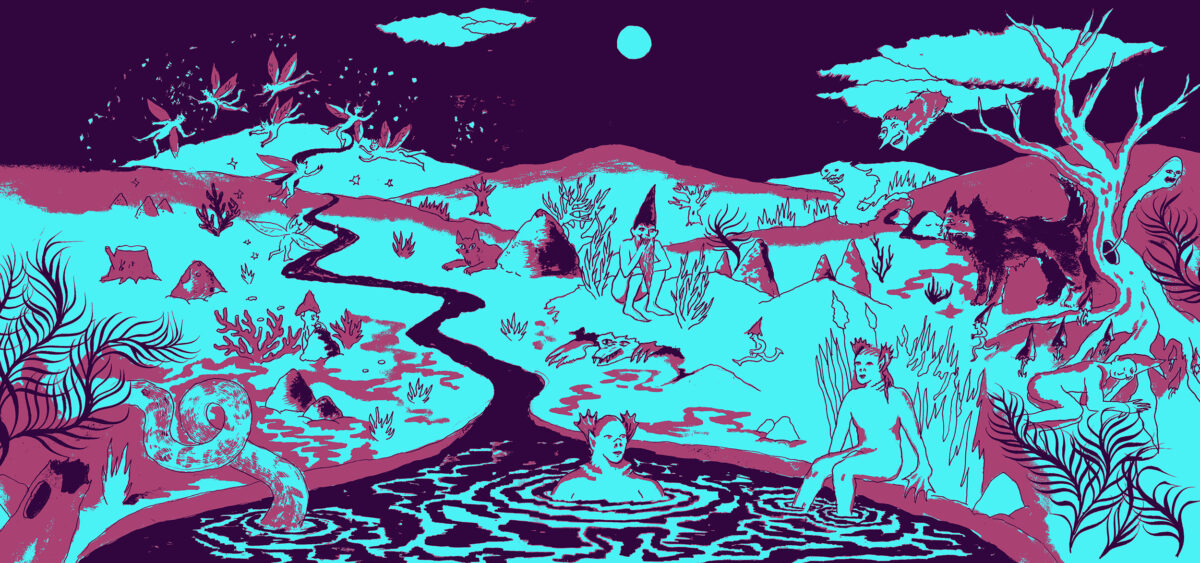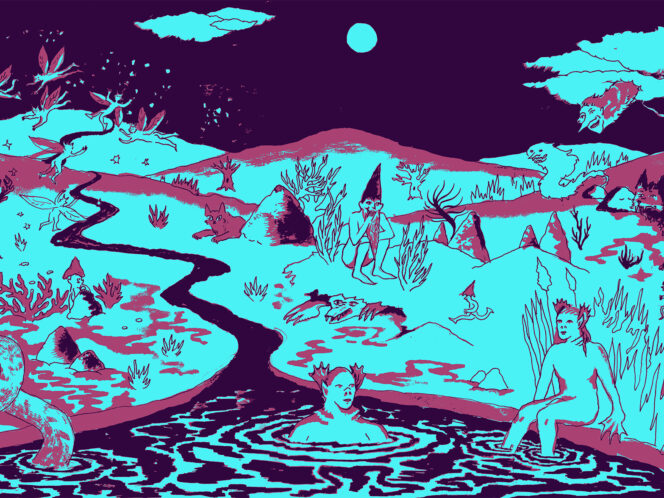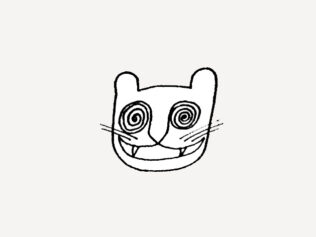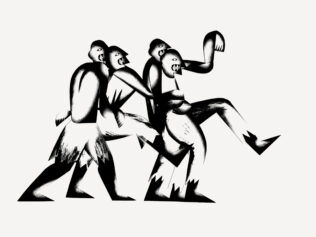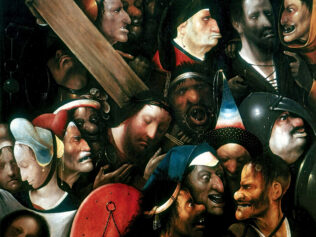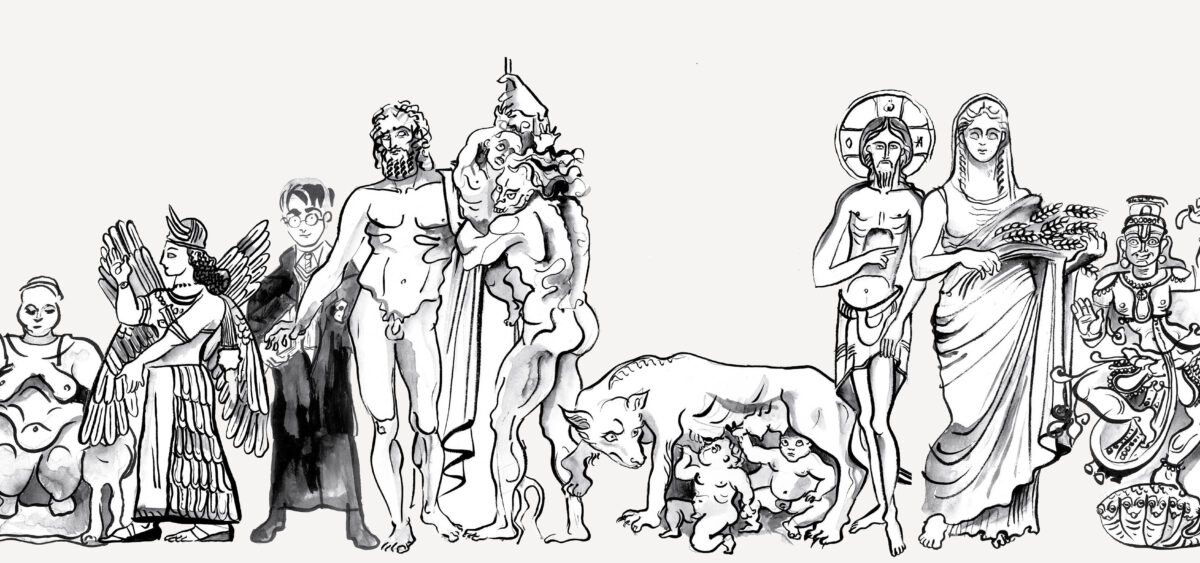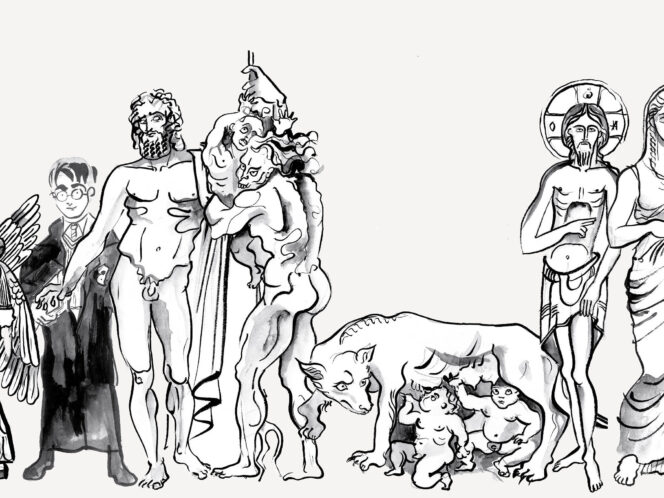
time 10 minutes
Imagine it is winter, and you are late for an appointment. You wanted to make a shortcut through the old park that had been in the centre of the town since Prussian times, but now it’s getting dark and the paths all seem to be longer and more winding than you expected; there are not enough street lamps to light the falling dusk. In the bare trees around you, crows are sitting, cawing menacingly. You cross the small bridge that leads across the lake in the centre of the park, and suddenly there is movement in the water, strange motions under the surface – too many to be those of fish. You stop and lean over the railing to see what it might be. Then you see two eyes staring back at you.
The Polish province of Warmia-Masuria is a wonderful place, full of pleasant rolling fields and wooded hills, hundreds of deep lakes and rivers, big and small. This is a pleasant holiday destination and extremely popular with summer visitors who flock here for swimming, kayaking and sailing; who can enjoy the amazing food of this mostly agricultural area, namely fresh fish, mushrooms, blueberries and the delicious local beers brewed here.
When the summer visitors are gone, however, this is a very different place, especially in the autumn and winter. Dark, cold, the lakes frozen over and the trees on the shores no longer giving shade, but instead resembling menacing scarecrows. In between the rolling hills sit dark moors; the rivers no longer gurgle pleasantly, instead taking on a threatening air. It is a landscape that demands respect in all seasons, and the people living here have always known this. In winter, they hide inside to weather out the snowstorms, like they have done for centuries. The time spent inside is a good opportunity to retell the stories about the moors and lakes and the ghosts that inhabit them – folklore dressing danger as the supernatural to make it palatable for children, perhaps. No wonder, then, that this landscape breeds spirits and demons.
Maybe the inhabitants make this place special. Warmia and Masuria have seen many people make it their home. The original inhabitants (who gave their name to Warmia and Prussia itself) – the pagan Prūsai, Pruzzen or Old Prussians – were conquered by the German Teutonic Order of knights in the 13th century. The knights, who had slaughtered many of the Old Prussians, then in turn brought in German settlers from the West and Polish colonists from the region of Masovia, who became locally known as Masurians, Mazurzy. The myths and beliefs of the Old Prussians in nature deities merged with the new population over the centuries. Across a period of almost 200 years, the region saw various partitions, displacements and population exchanges, most recently when the borders of newly-independent Poland were drawn following the German defeat in World War II. During and after the war, almost all of the German population of Masuria either fled or was relocated to Germany. Yet many of the Warmian and Masurian families here – who spoke a Polish dialect and were often active in the cultural activities of the Polish minority before 1939 – stayed on and mixed with the newly-arriving Polish expellees from the East.
And so the old stories live on, the myths of Germans, Slavs and Old Prussians all intertwined. Little wonder, then, that a large part of Warmian and Masurian folklore to this day paints a dark, almost demonic picture of the landscape. Natural phenomena are demonized and appear as places of unpredictable dark forces. The horror of dark woods, black and menacing moors, of the frightening deep of the lakes is present in many folk tales. Ghost stories about wood spirits and the spirits of the dead that wander around the villages and haunt or lead the living astray is another popular theme in the local folklore. Here are some of the creatures (with their names given first in Polish, then in German) that you might want to avoid the next time you visit Warmia-Masuria:
Topnik or utopiec; Toppich – the drowned demon
The spirits of human souls that died drowning, residing in the element of their own demise, always looking for fresh victims. It is horrible to spend eternity alone as a topnik, the tortured spirit of one who has met a watery death – and so with a desire for company in its suffering, it waits for unsuspecting walkers in its quiet pond or moor, before grabbing and pulling them below the surface, where it holds them tight while the last bubbles of air and life escape from their lungs… According to some stories, the topnik can take the form of a child or a child-sized man in soaked, muddy clothes. It sometimes wears a red cap, which it can also use to draw its victims in by hanging it on on a tree branch or bush. Whoever wandered by and plucked it off would be grabbed by the demon and pulled to a watery death. It can also take on a more terrifying look: a hairy human torso supporting a red head.
Zmora; Smora – the life-sucking demon
Vicious half-demonic creatures. They draw energy from the living by feeding on their vital forces, but aren’t able to kill them directly. A zmora is a person alive or dead, such as a sinful woman, someone wronged, or someone who died without confession. They can take a variety of living and non-living forms: human, cat, dog, frog, and even threads, straws or apples. Activities such as going out to the stable with damp hair or washing dishes on Thursday after dinner might result in a zmora being brought into the house. Other signs of someone being a zmora include being the seventh daughter, having one’s name pronounced wrongly while being baptized, or having multi-coloured eyes. If a woman was promised to marry a man, but he then married another, the spurned woman could also become a zmora during the night.
Many German and Polish folk myths often describe the zmora as sitting on a sleeping person’s legs or chest, thereby causing sleep paralysis or breathing problems. The zmora would also harass animals, especially horses or cows. A horse visited by a zmora at night would be sweaty and visibly exhausted in the morning. To keep it away from the stable, you should place an axe under your doorstep. People can also protect themselves from zmora by fumigating the bedroom with special herbs, keeping holy water close to the bed, or going to sleep with an axe or another sharp metal object closeby. In an old tale from Hohenstein/Olsztynek (recorded in Superstitions in Masuria by the German folklorist Max Toeppen and printed in 1867), two travelling journeymen discover that the three daughters of the keeper of the inn where they are staying are all zmora, as the women are sleepless and can be overheard talking about their hard fate of being forced to draw life energy from humans, cattle and trees. They are healed by their father baptizing them again, which draws out the evil.
Mamuna or dziwożona – the swamp demon
Another swamp demon – a female one this time, but again a human soul turned monster. Most at risk of becoming a mamuna after death are midwives, old maids, unmarried mothers, pregnant women who die before childbirth, as well as abandoned children born out of wedlock.
The mamuna lives in thickets near rivers, streams and lakes, and can take the form of an ugly, old woman with a hairy body and long straight hair. However, she is also a shape-shifter and can appear as a beautiful nymph capable of luring men to their watery deaths. She often kidnaps human babies just after birth and replaces them with her own changeling offspring. A changeling can be recognized by its uncommon appearance: it has a huge abdomen, a head that is too small or too big, a hump, thin arms and legs, a hairy body and long claws. Mothers can prevent their children being abducted by the mamuna by tying a red ribbon around the child’s hand, placing a red hat on its head, or shielding its face from the light of the moon.
Diabeł; Teufel – the Devil
As Christianization approached the region, it needed another fiend, so it’s no wonder that the devil (diabeł or Teufel) makes an appearance in many Warmian-Masurian folk tales, too. A story about him was recorded by Priest Groß in Klaussen/Klusy in 1786, referring to older church records: in 1640, during mass, Pastor Wisniewski expelled the devil from a local woman who was possessed by it. The fiend appeared on the church threshold as a horrible shape, and was finally forced to flee when Wisniewski accused him of his sins, over which the devil became so irate that he shouted, “I have stopped torturing the woman, but as true as I am the devil, you should have a souvenir from me!” before slamming his crooked foot down on the threshold. To this day, four human toes and the heel of a rooster can be seen in the stone.
The news of this exorcism, in connection with the imprint of the devil’s foot, prompted the Poles and Tartars not to burn this church when they invaded in 1656. When the church was rebuilt in 1754, the stone was removed from its previous location in front of the church door so that pregnant women no longer had to step over it.
Kłobuk; Kaubuk – the benevolent chicken spirit
Speaking of chicken, the kłobuk is a benevolent spirit; a household deity like the Russian domovoy, and very popular in Warmia to this day. Instead of looking like the little old man that is the domovoy, the Warmian kłobuk is feathered and is said to mostly resemble a large chicken (or other birds, such as the magpie or duck). A kłobuk can be brought into the house, which it will then accept as its own if tempted with food – including its favourites, boiled eggs and noodles – or through the owners hugging a chicken. It is also possible to ‘grow’ a kłobuk, by burying a miscarried fetus under the threshold of the house, which after seven days, seven months or seven years will turn into the chicken-like spirit. The kłobuk ensures that the possessions of its homeowners will multiply, but does this mostly through stealing from neighbours. It can be extremely irksome and tenacious though, meaning that those living with a kłobuk should tread carefully. If they offend the creature, it might unexpectedly leave the house, or take revenge on the owners by setting fire to their abode.
Kautek; Kobold – the minuscule house spirit
Another friendly house spirit, but not in chicken form this time. These creatures have the appearance of men only a few centimeters tall, sometimes dressed in red clothes or wearing a red hat. The name allegedly derives from the Old Prussian language, where kauks means ‘the devil’. Yet despite its name, the kautek is actually quite benevolent once it picks a house to live in – it will do many small household chores overnight while the humans are asleep.
Like the kłobuk, it is somewhat capricious and has a darker side: it usually likes to play pranks on neighbours, and might bring illnesses to certain family members. It might even swap one of its own children with the babies of the host, leaving a changeling to grow up as a human child.
The landscape of Warmia-Masuria has left an imprint on its people and their imagination, both in the past and modern times. Indeed, up until this day, its inhabitants playfully and respectfully engage with their mythology: there are kłobuk statues made from wood strewn around many villages here, the Olsztyn arts magazine VariArt dedicated a whole issue to its artistic representation, and last year a topnik-themed exhibition took place in Olsztyn, where Polish artists not only engaged with monsters from folklore, but also with the German experience of flight and expulsion. The demons and spirits have seem to have finally found a less threatening place in the artistic culture of Warmia-Masuria, no longer luring people into the moors.
Or maybe they still do – so be careful next time you walk too close to a quiet and dark Masurian lake. You never really know what lurks beneath the surface…
While researching this article, I used the following texts and resources:
Max Toeppen, Aberglauben aus Masuren [Superstitions from Masuria], 1867
Sagen aus Pommern (Ermland, Masuren) [Legends from Pomerania (Warmia-Mazuria)], online
Agnieszka Grochocka, Masuren – vom Naturparadies zum Atlantis des Nordens, 2015 [Masuria – From Natural Paradise to the Atlantis of the North]
Online Encyclopedia of Warmia and Masuria (Polish)

